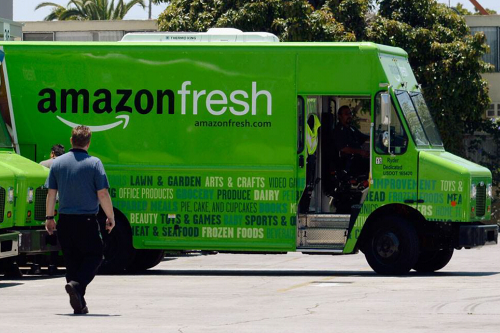Amazon Is About to Transform How You Buy Groceries
Amazon has been trying to crack the food delivery business for a decade. Today it may have finally figured out how: Buy a supermarket.
In its biggest acquisition ever, Amazon has agreed to buy the Whole Foods supermarket chain for $13.7 billion. Given the Everything Store’s adventures in groceries so far, this promises to redefine what a trip to the grocery store looks like.
Although the deal surprised a lot of people, the e-commerce giant has long wanted to figure out the online groceries game. It started testing delivery concepts in August 2007, when it unveiled Amazon Fresh – delivering produce and pantry staples through its fulfillment centers. Yet even after a decade – eons inSilicon Valleytime – it’s still trying. Turns out, the instant gratification business doesn’t quite work with fresh food.
Still, the market is just too lucrative – and too primed for disruption – for Amazon to simply give up.
“Amazon buying Whole Foods is a good fit with the company’s larger strategy for groceries,” says Jason Goldberg, vice president of commerce at the digital marketing company Razorfish. “Fresh groceries are the biggest category of consumer spending in retail that hasn’t been disrupted by online yet.”
A recent report from the Food Marketing Institute and Nielsen found that the US grocery sector could grow five-fold in the next decade, with consumers spending upward of $100 billion by 2025. While around a quarter of US households currently shop online for groceries – up from 20 percent just three years ago – more than 70 percent will do so within 10 years, according to the report.
Amazon saw the potential here early on, but Amazon Fresh still hasn’t caught on in any meaningful way. Selling fresh food requires a more hands-on experience than delivering the typical Amazon package does. A lot of the stuff you buy in a grocery store spoils easily, which means you have to get them home quickly – plus, someone has to be there to receive the goods. That can be tricky, given how Amazon likes to optimize delivery routes and bundle items to maximize efficiency. “You can’t do that with milk,” says Goldberg.
That explains why Amazon has shifted from figuring out how to deliver fresh food to remaking the grocery store.
Take Amazon Fresh Pickup, which launched in March. Customers order groceries online, then drive to an Amazon-run store, where employees bring the bags right to their car. Walmart and Kroger offer similar services, but need two to four hours to get an order together. Amazon does it in 15 minutes.

By May, Amazon had opened two stores in Seattle. Now it can potentially expand the model to 431 Whole Foods markets nationwide. Assuming the deal passes regulatory muster, shopping at Whole Foods may well mean never again walking down a crowded aisle. “What’s emerged as the best digital solution for fresh groceries is: order ahead, pick up in store,” says Goldberg. “What we’re seeing today is the first step in Amazon’s strategy to acquire locations that get closer to the consumer.”
Another Amazon concept looks even further into the future. In December, Amazon launched a beta of Amazon Go, a supermarket with no cashiers. Just grab and go; embedded sensors and other technology keep track of what you bought. So far, only Amazon employees can shop at one Amazon Go location by the company’s headquarters; technical issues have kept the company from rolling it out.
Both models aim to minimize friction in the shopping experience – and, it should be said, reduce labor costs. In Amazon’s world, you don’t even get out of the car. And if you do enter a supermarket, you can get what you want without so much as reaching for your wallet or phone.
Of course, buying Whole Foods doesn’t help Amazon reach the rural areas where Walmart rules. “Amazon is stronger in bigger cities, and the map of Whole Foods locations shows it is closer to these cities,” says Goldberg. Still, you can see the Whole Foods deal being the first step in a larger plan. “If this strategy proves out for Amazon, you could well imagine it could be opening a bunch more stores or doing more acquisitions just to cover theUS,” says Goldberg. “And you could imagine it might have similar plays that it’s evaluating in other markets.”
Before that can happen, though, Amazon must make sure its wild ideas will work at scale. “The question is, how can they accelerate this?” says ChannelAdvisor executive chairman Scot Wingo, an analyst who tracks Amazon closely.
Looking beyond delivery methods, Amazon could use Whole Foods stores to market its own electronics and products. Or, it could let you order your entire grocery list using Amazon Echo and its voice-activated assistant Alexa.
“Considering the possibilities,” Wingo says, “The grocery delivery part may even be the easiest thing for Amazon to work out. Yesterday, Amazon was probably in the top 50 grocery players, and now, by our estimates, it’s around number five,” he says. “If there’s anything I’ve learned in the last two decades, it’s not to say it’s impossible for Amazon to be a top player in any category of goods.”
It seems likely that it will get there in groceries the same way it has in its other consumer-facing products: changing the way you shop.








